Analytical Models for Pose Estimate Variance of Planar Fiducial Markers for Mobile Robot Localisation
Abstract
1. Introduction
1.1. Passive Fiducial Markers
- Kinematic calibration for industrial robots;
- Visual servoing of industrial robots;
- Robot navigation tasks;
- Localisation and mapping tasks;
- Human–machine interaction.
- Degradation of accuracy with distance [16];
- Marker size: according to Szentandrási et al. [17] (p. 1) “the markers must be large enough to provide sufficient amount of information and at the same time they must be small enough to fit into the camera’s field of view”;
- Optical system limitations [5]: physical properties of the image acquisition system, e.g., resolution.
1.2. Extended Kalman Filter
2. Related Works
3. Problem Definition
4. Experimental Measurements of Pose Estimation Noise
4.1. Experiment Setup
4.2. Measurement Results
4.3. Simulation Results
4.4. Conclusion of Measurements
5. Analytical Models of Pose Variance
5.1. Marker Area Normalisation
5.2. Model of Variance
- The variance increases sharply at the edge of the detectability of the marker.
- The variance has a Gaussian shape around the point where the normal vector of the marker points towards the camera.
- The peak of the variance increases with increasing distance from the marker and consequently with a decreasing area of the detected marker.
5.3. Models of and Variances
- Variance sharply increases at the edge of the detectability of the marker.
- The variance increases with increasing distance from the marker and consequently with decreasing detected marker area.
- The variance is not significantly dependent on the yaw angle .
6. Practical Application of Variance Models in 2D Mobile Robot Localisation
6.1. Parameter Estimation on User Data
6.2. Transformation of Measurements to Global Coordinate System
6.3. Fusion of Pose from Multiple Markers
6.4. EKF Localisation
6.5. Results
7. Discussion
8. Conclusions
Author Contributions
Funding
Institutional Review Board Statement
Informed Consent Statement
Data Availability Statement
Conflicts of Interest
References
- Cebollada, S.; Payá, L.; Flores, M.; Peidró, A.; Reinoso, O. A state-of-the-art review on mobile robotics tasks using artificial intelligence and visual data. Expert Syst. Appl. 2021, 167, 114195. [Google Scholar] [CrossRef]
- Rubio, F.; Valero, F.; Llopis-Albert, C. A review of mobile robots: Concepts, methods, theoretical framework, and applications. Int. J. Adv. Robot. Syst. 2019, 16, 1729881419839596. [Google Scholar] [CrossRef]
- Niloy, M.A.K.; Shama, A.; Chakrabortty, R.K.; Ryan, M.J.; Badal, F.R.; Tasneem, Z.; Ahamed, M.H.; Moyeen, S.I.; Das, S.K.; Ali, M.F.; et al. Critical Design and Control Issues of Indoor Autonomous Mobile Robots: A Review. IEEE Access 2021, 9, 35338–35370. [Google Scholar] [CrossRef]
- Jang, G.; Kim, S.; Lee, W.; Kweon, I. Robust self-localization of mobile robots using artificial and natural landmarks. In Proceedings of the 2003 IEEE International Symposium on Computational Intelligence in Robotics and Automation. Computational Intelligence in Robotics and Automation for the New Millennium (Cat. No.03EX694), Kobe, Japan, 16–20 July 2003; Volume 1, pp. 412–417. [Google Scholar] [CrossRef]
- Popescu, D.C.; Cernaianu, M.O.; Ghenuche, P.; Dumitrache, I. An assessment on the accuracy of high precision 3D positioning using planar fiducial markers. In Proceedings of the 2017 21st International Conference on System Theory, Control and Computing, Sinaia, Romania, 19–21 October 2017; pp. 471–476. [Google Scholar] [CrossRef]
- Deasy, T.P.; Scanlon, W.G. Stepwise Algorithms for Improving the Accuracy of Both Deterministic and Probabilistic Methods in WLAN-based Indoor User Localisation. Int. J. Wirel. Inf. Netw. 2004, 11, 207–216. [Google Scholar] [CrossRef]
- Ledergerber, A.; Hamer, M.; D’Andrea, R. A robot self-localization system using one-way ultra-wideband communication. In Proceedings of the 2015 IEEE/RSJ International Conference on Intelligent Robots and Systems, Hamburg, Germany, 28 September–2 October 2015; pp. 3131–3137. [Google Scholar]
- Krejsa, J.; Věchet, S.; Hrbácek, J.; Ripel, T.; Ondroušek, V.; Hrbácek, R.; Schreiber, P. Presentation Robot Advee. Eng. Mech. 2011, 18, 307–322. [Google Scholar]
- Babinec, A.; Jurišica, L.; Hubinský, P.; Duchoň, F. Visual Localization of Mobile Robot Using Artificial Markers. Procedia Eng. 2014, 96, 1–9. [Google Scholar] [CrossRef]
- Bertoni, M.; Michieletto, S.; Oboe, R.; Michieletto, G. Indoor Visual-Based Localization System for Multi-Rotor UAVs. Sensors 2022, 22, 5798. [Google Scholar] [CrossRef] [PubMed]
- Kayhani, N.; Heins, A.; Zhao, W.; Nahangi, M.; McCabe, B.; Schoellig, A. Improved Tag-based Indoor Localization of UAVs Using Extended Kalman Filter. In Proceedings of the ISARC. International Symposium on Automation and Robotics in Construction, Banff, AB, Canada, 21–24 May 2019; pp. 624–631. [Google Scholar] [CrossRef]
- Fiala, M. Designing Highly Reliable Fiducial Markers. IEEE Trans. Pattern Anal. Mach. Intell. 2010, 32, 1317–1324. [Google Scholar] [CrossRef] [PubMed]
- Abbas, S.M.; Aslam, S.; Berns, K.; Muhammad, A. Analysis and Improvements in AprilTag Based State Estimation. Sensors 2019, 19, 5480. [Google Scholar] [CrossRef] [PubMed]
- Tanaka, H.; Sumi, Y.; Matsumoto, Y. A solution to pose ambiguity of visual markers using Moiré patterns. In Proceedings of the 2014 IEEE/RSJ International Conference on Intelligent Robots and Systems, Chicago, IL, USA, 14–18 September 2014; pp. 3129–3134. [Google Scholar] [CrossRef]
- Ch’ng, S.F.; Sogi, N.; Purkait, P.; Chin, T.J.; Fukui, K. Resolving Marker Pose Ambiguity by Robust Rotation Averaging with Clique Constraints. In Proceedings of the 2020 IEEE International Conference on Robotics and Automation, Paris, France, 31 May–31 August 2020. [Google Scholar]
- Kalaitzakis, M.; Carroll, S.; Ambrosi, A.; Whitehead, C.; Vitzilaios, N. Experimental Comparison of Fiducial Markers for Pose Estimation. In Proceedings of the 2020 International Conference on Unmanned Aircraft Systems (ICUAS), Athens, Greece, 1–4 September 2020; pp. 781–789. [Google Scholar] [CrossRef]
- Szentandrási, I.; Zachariáš, M.; Havel, J.; Herout, A.; Dubská, M.; Kajan, R. Uniform Marker Fields: Camera localization by orientable De Bruijn tori. In Proceedings of the 2012 IEEE International Symposium on Mixed and Augmented Reality (ISMAR), Atlanta, GA, USA, 5–8 November 2012; pp. 319–320. [Google Scholar] [CrossRef]
- Neunert, M.; Bloesch, M.; Buchli, J. An open source, fiducial based, visual-inertial motion capture system. In Proceedings of the 2016 19th International Conference on Information Fusion (FUSION), Heidelberg, Germany, 5–8 July 2016; pp. 1523–1530. [Google Scholar]
- Kalman, R.E. A New Approach to Linear Filtering and Prediction Problems. Trans. ASME J. Basic Eng. 1960, 82, 35–45. [Google Scholar] [CrossRef]
- Mcgee, L.A.; Schmidt, S.F. Discovery of the Kalman Filter as a Practical Tool for Aerospace and Industry; National Aeronautics and Space Administration: Pasadena, CA, USA, 1985.
- Brablc, M. Hybrid Method for Modelling and State Estimation of Dynamic Systems; Brno University of Technology: Brno, Czech Republic, 2023. [Google Scholar]
- Tung, C.P.; Kak, A. Integrating sensing, task planning, and execution for robotic assembly. IEEE Trans. Robot. Autom. 1996, 12, 187–201. [Google Scholar] [CrossRef]
- Rekimoto, J. Matrix: A realtime object identification and registration method for augmented reality. In Proceedings of the 3rd Asia Pacific Computer Human Interaction (Cat. No.98EX110), Shonan Village Center, Japan, 17 July 1998; pp. 63–68. [Google Scholar] [CrossRef]
- Stricker, D.; Klinker, G.; Reiners, D. A fast and robust line-based optical tracker for augmented reality applications. In Proceedings of the International Workshop on Augmented Reality (IWAR’98), San Francisco, CA, USA, 1 November 1998. [Google Scholar]
- Kato, H.; Billinghurst, M. Marker tracking and HMD calibration for a video-based augmented reality conferencing system. In Proceedings of the Proceedings 2nd IEEE and ACM International Workshop on Augmented Reality (IWAR’99), San Francisco, CA, USA, 20–21 October 1999; pp. 85–94. [Google Scholar] [CrossRef]
- Fiala, M. ARTag, a fiducial marker system using digital techniques. In Proceedings of the 2005 IEEE Computer Society Conference on Computer Vision and Pattern Recognition, San Diego, CA, USA, 20–25 June 2005; Volume 2, pp. 590–596. [Google Scholar] [CrossRef]
- Olson, E. AprilTag: A robust and flexible visual fiducial system. In Proceedings of the 2011 IEEE International Conference on Robotics and Automation, Shanghai, China, 9–13 May 2011; pp. 3400–3407. [Google Scholar] [CrossRef]
- Benligiray, B.; Topal, C.; Akinlar, C. STag: A Stable Fiducial Marker System. Image Vis. Comput. 2017, 89, 158–169. [Google Scholar] [CrossRef]
- Vávra, P. Využití Nástroje ROS pro Řízení Autonomního Mobilního Robotu. Master’s Thesis, University of Technology in Brno, Brno, Czech Republic, 2019. [Google Scholar]
- López-Cerón, A.; Cañas, J.M. Accuracy analysis of marker-based 3D visual localization. In Proceedings of the XXXVII Jornadas de Automática Jornadas de Automática 2016, Madrid, Spain, 7–9 September 2022. [Google Scholar]
- Abawi, D.; Bienwald, J.; Dorner, R. Accuracy in optical tracking with fiducial markers: An accuracy function for ARToolKit. In Proceedings of the Third IEEE and ACM International Symposium on Mixed and Augmented Reality, Arlington, VA, USA, 5 November 2004; pp. 260–261. [Google Scholar] [CrossRef]
- Pentenrieder, K.; Meier, P.; Klinker, G. Analysis of Tracking Accuracy for Single-Camera Square-Marker-Based Tracking. In Proceedings of the Dritter Workshop Virtuelle und Erweiterte Realitt der GIFachgruppe VR/AR, Koblenz, Germany, 25–26 September 2006. [Google Scholar]
- Tanaka, H.; Sumi, Y.; Matsumoto, Y. Avisual marker for precise pose estimation based on lenticular lenses. In Proceedings of the 2012 IEEE International Conference on Robotics and Automation, Saint Paul, MN, USA, 14–18 May 2012; pp. 5222–5227. [Google Scholar] [CrossRef]
- Uchiyama, H.; Saito, H. Random dot markers. In Proceedings of the 2011 IEEE Virtual Reality Conference, Singapore, 19–23 March 2011; pp. 35–38. [Google Scholar] [CrossRef]
- Mateos, L.A. AprilTags 3D: Dynamic Fiducial Markers for Robust Pose Estimation in Highly Reflective Environments and Indirect Communication in Swarm Robotics. arXiv 2020, arXiv:2001.08622. [Google Scholar] [CrossRef]
- Zheng, J.; Bi, S.; Cao, B.; Yang, D. Visual Localization of Inspection Robot Using Extended Kalman Filter and Aruco Markers. In Proceedings of the 2018 IEEE International Conference on Robotics and Biomimetics, Kuala Lumpur, Malaysia, 12–15 December 2018; pp. 742–747. [Google Scholar] [CrossRef]
- Chavez, A.G.; Mueller, C.A.; Doernbach, T.; Birk, A. Underwater navigation using visual markers in the context of intervention missions. Int. J. Adv. Robot. Syst. 2019, 16, 1729881419838967. [Google Scholar] [CrossRef]
- Bradski, G. The OpenCV Library. Dobb’s J. Softw. Tools 2000, 25, 120–123. [Google Scholar]
- Koenig, N.; Howard, A. Design and use paradigms for Gazebo, an open-source multi-robot simulator. In Proceedings of the 2004 IEEE/RSJ International Conference on Intelligent Robots and Systems (IROS) (IEEE Cat. No.04CH37566), Sendai, Japan, 28 September–2 October 2004; Volume 3, pp. 2149–2154. [Google Scholar] [CrossRef]
- Blanco-Claraco, J.L. A tutorial on SE(3) transformation parameterizations and on-manifold optimization. arXiv 2021, arXiv:2103.15980. [Google Scholar]
- Petersen, K.B.; Pedersen, M.S. The Matrix Cookbook. Tech. Univ. Den. 2012, 7, 510. [Google Scholar]
- Quigley, M.; Conley, K.; Gerkey, B.; Faust, J.; Foote, T.; Leibs, J.; Wheeler, R.; Ng, A. ROS: An open-source Robot Operating System. In Proceedings of the ICRA Workshop on Open Source Software, Kobe, Japan, 12–17 May 2009; Volume 3. [Google Scholar]
- Madgwick, S.O.H.; Harrison, A.J.L.; Vaidyanathan, R. Estimation of IMU and MARG orientation using a gradient descent algorithm. In Proceedings of the 2011 IEEE International Conference on Rehabilitation Robotics, Zurich, Switzerland, 29 June–1 July 2011; pp. 1–7. [Google Scholar] [CrossRef]
- Meeussen, W. REP 105—Coordinate Frames for Mobile Platforms (ROS.org). 2010. Available online: https://www.ros.org/reps/rep-0105.html (accessed on 7 February 2023).
- Moore, T.; Stouch, D. A Generalized Extended Kalman Filter Implementation for the Robot Operating System. In Proceedings of the 13th International Conference on Intelligent Autonomous Systems (IAS-13), Padova, Italy, 15–18 July 2014. [Google Scholar]
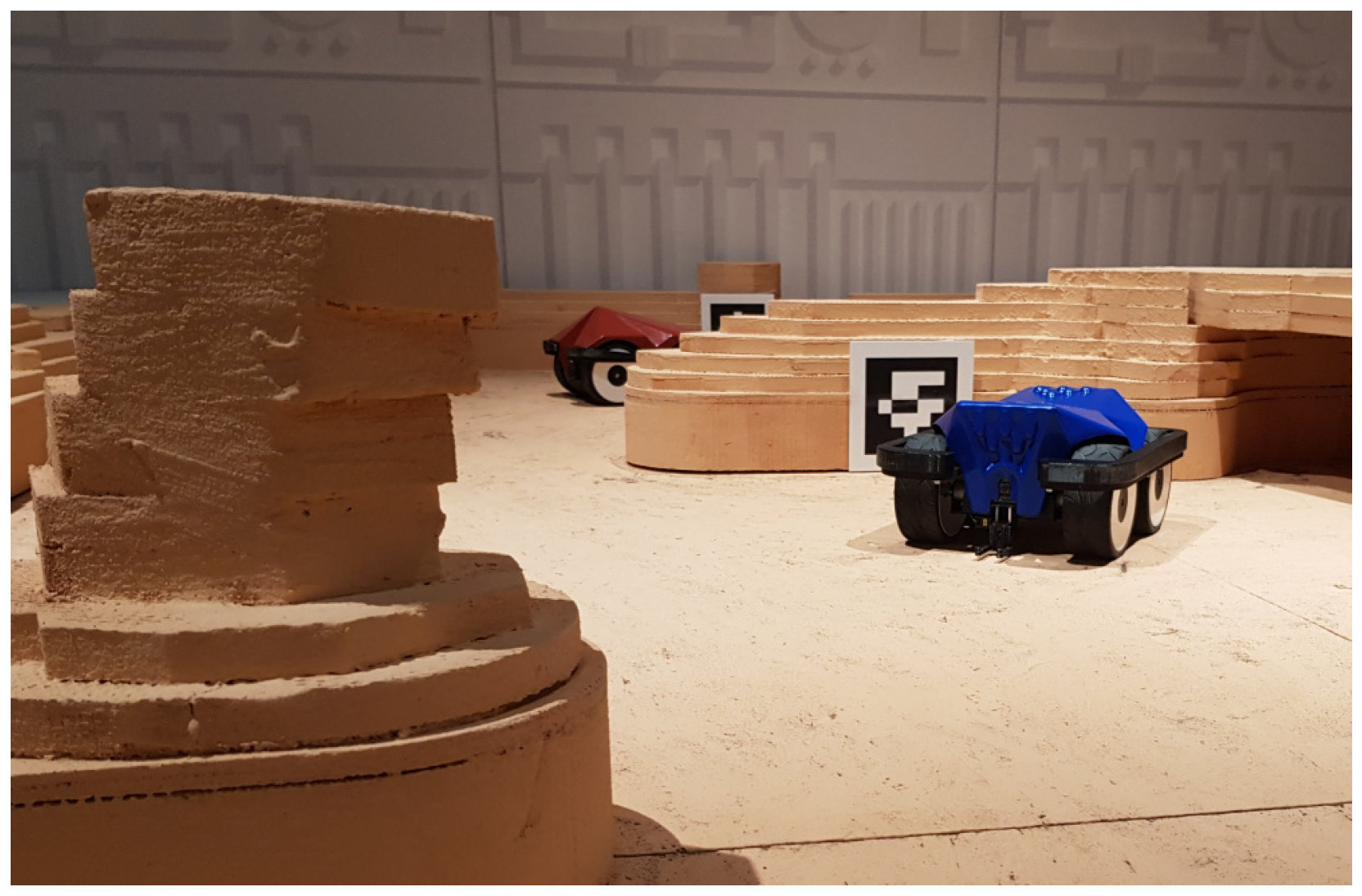





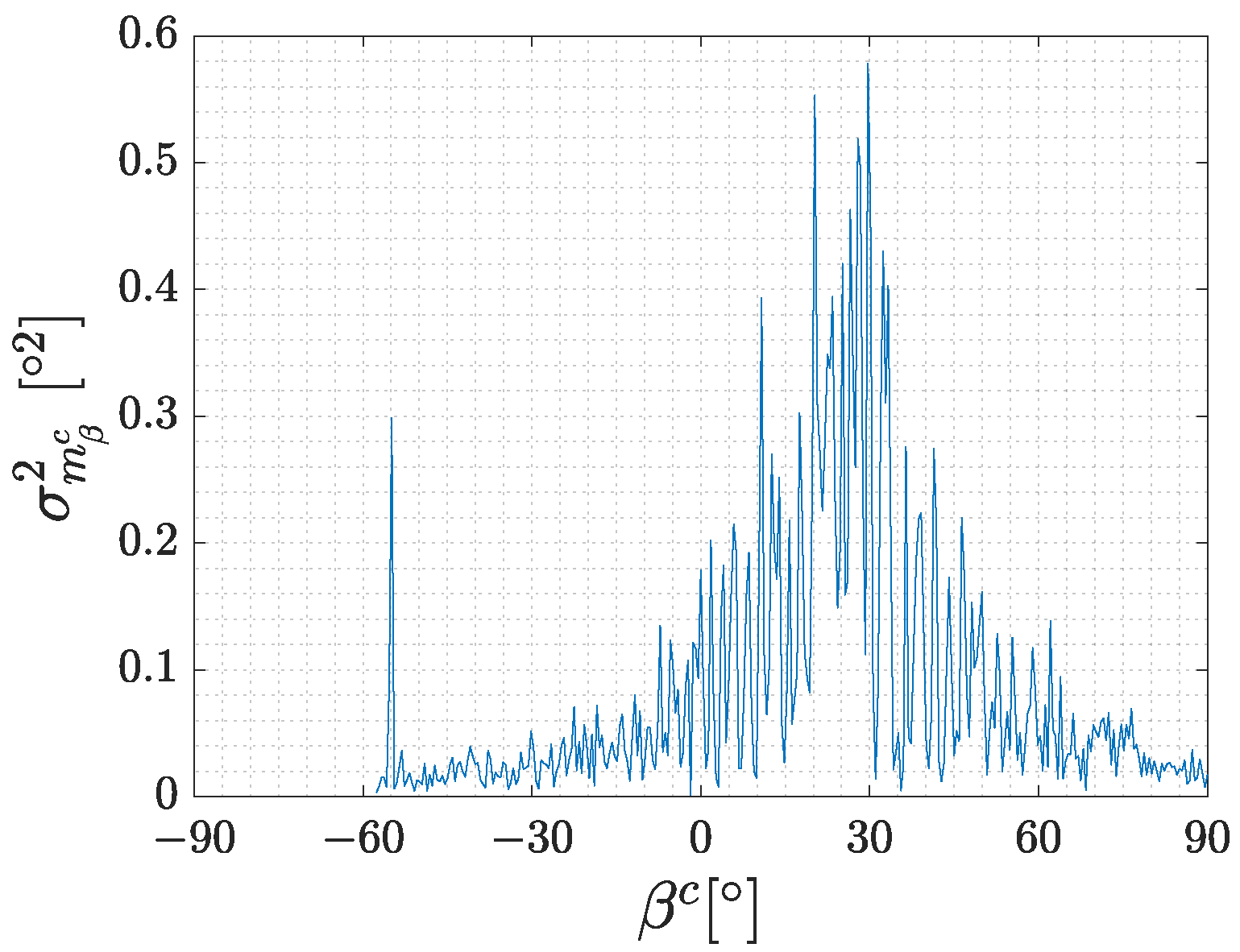


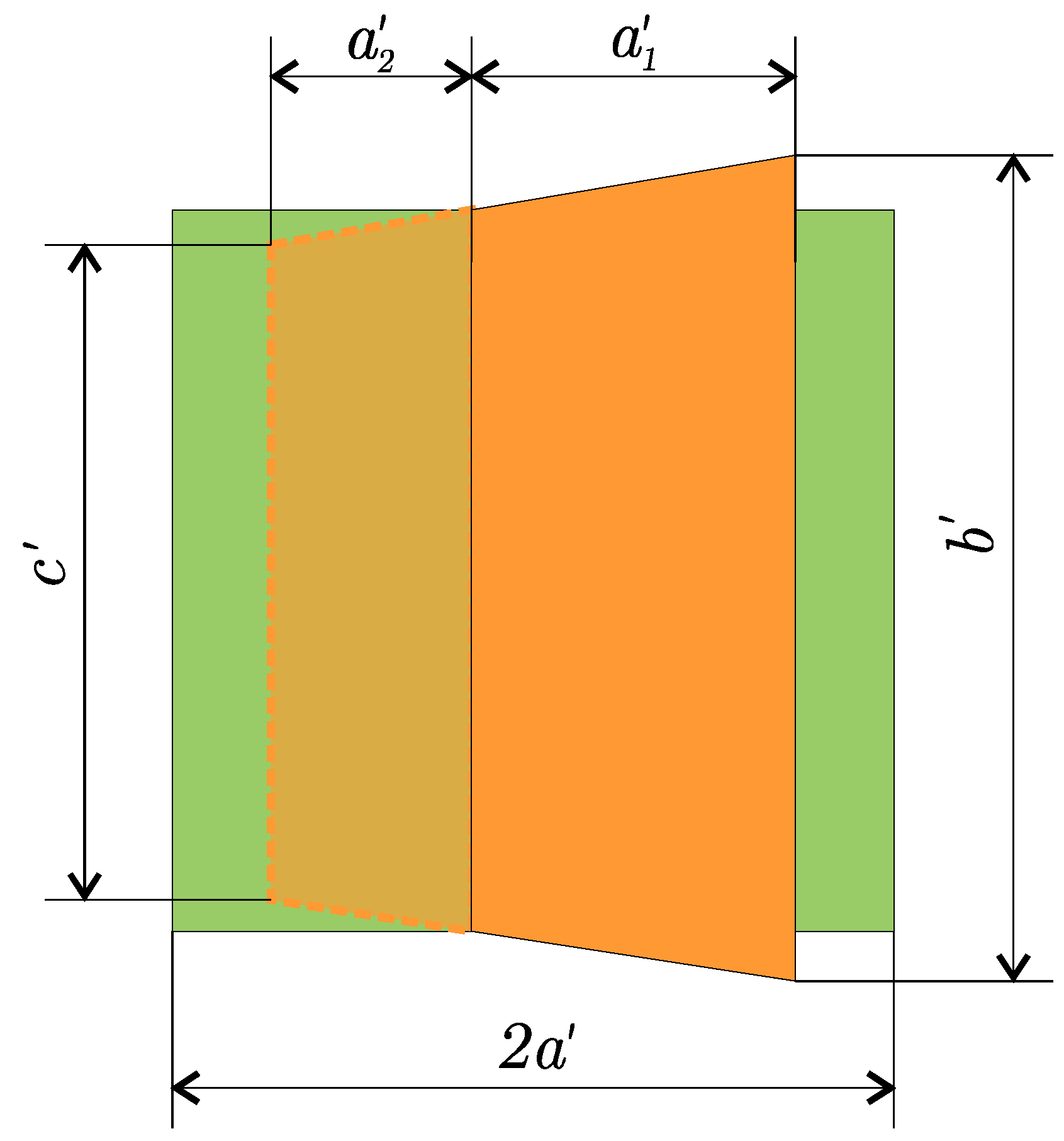
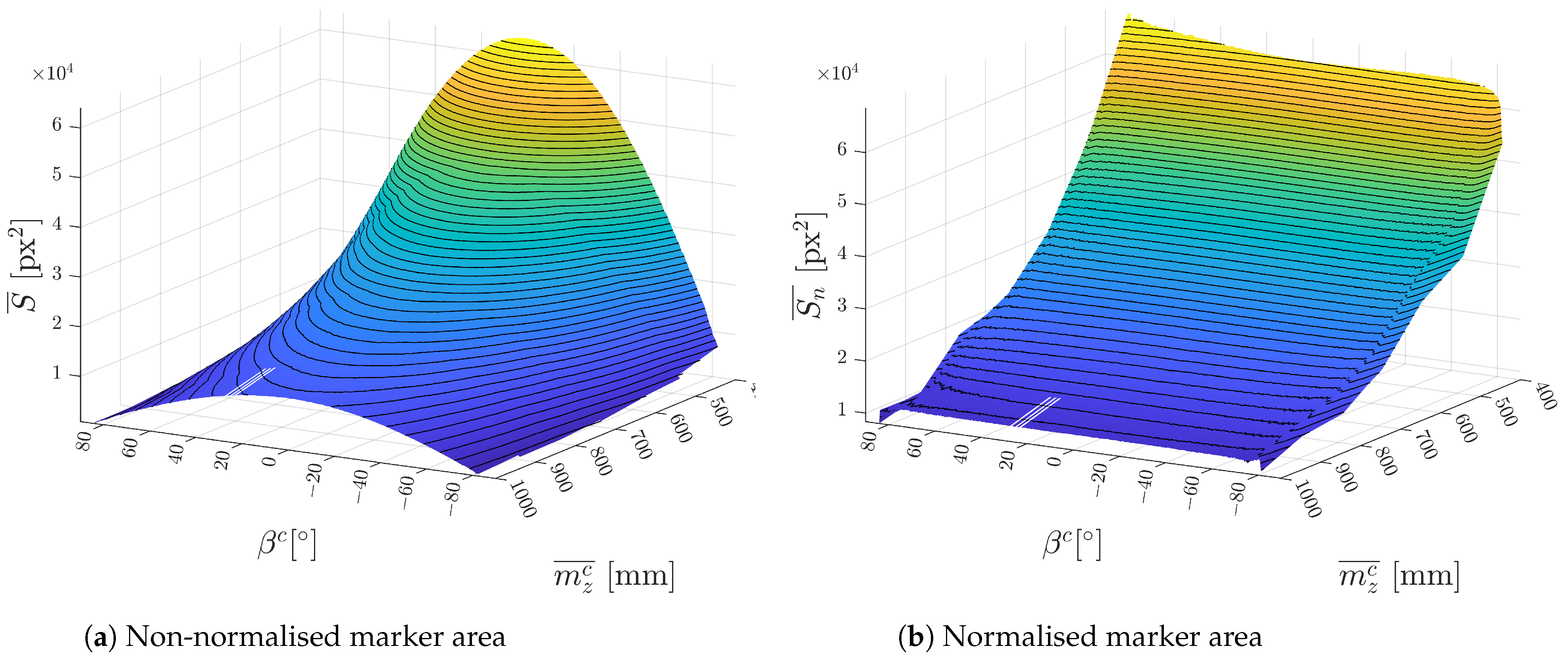

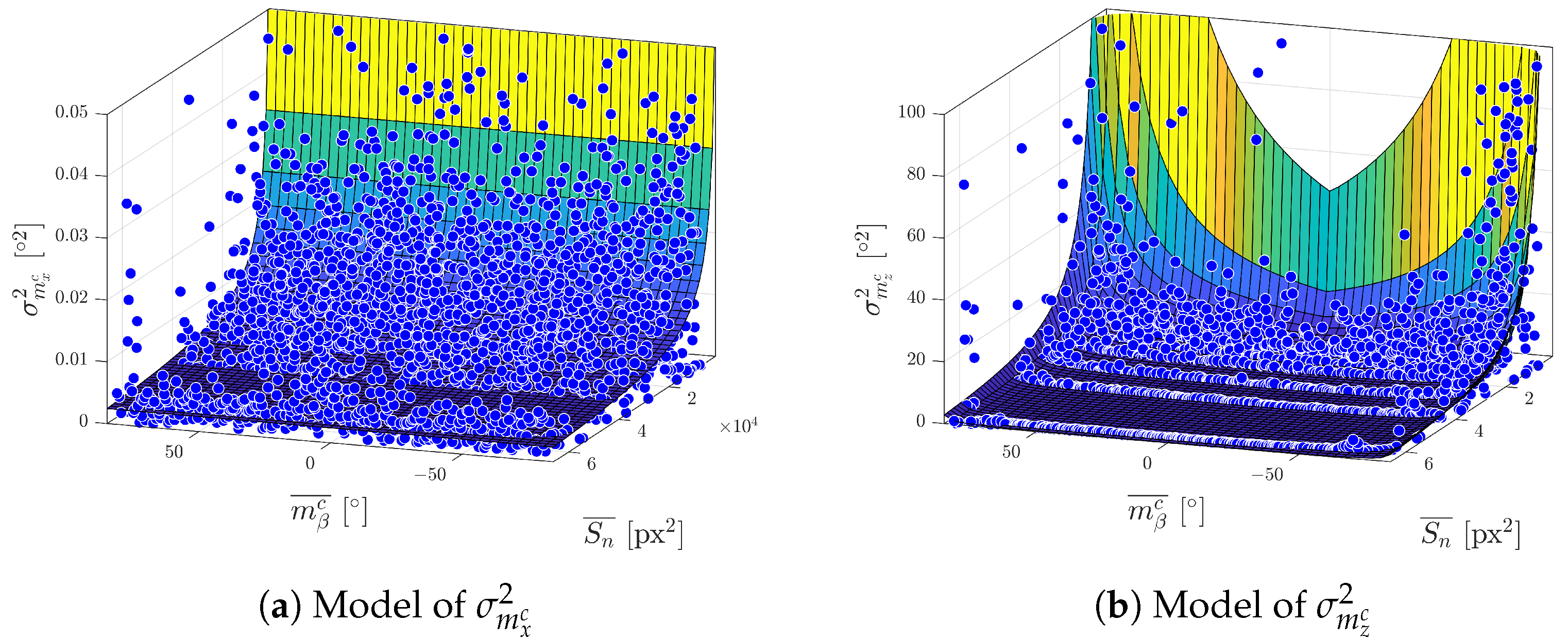



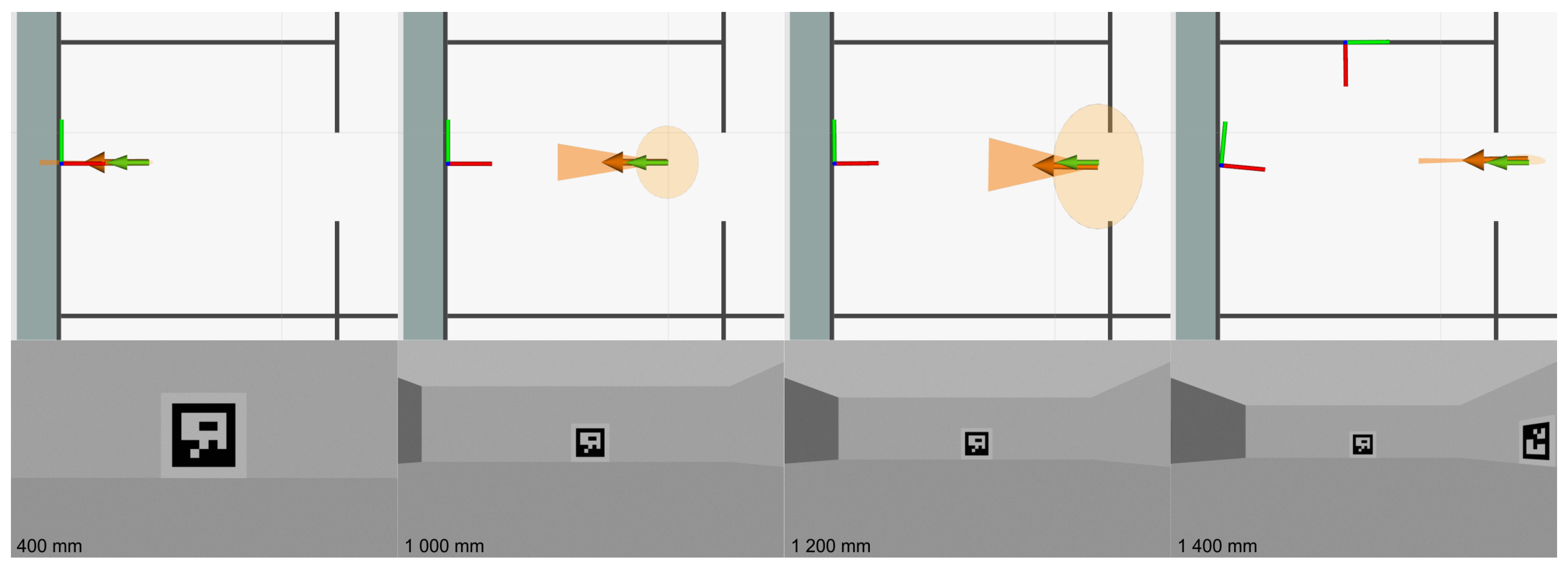

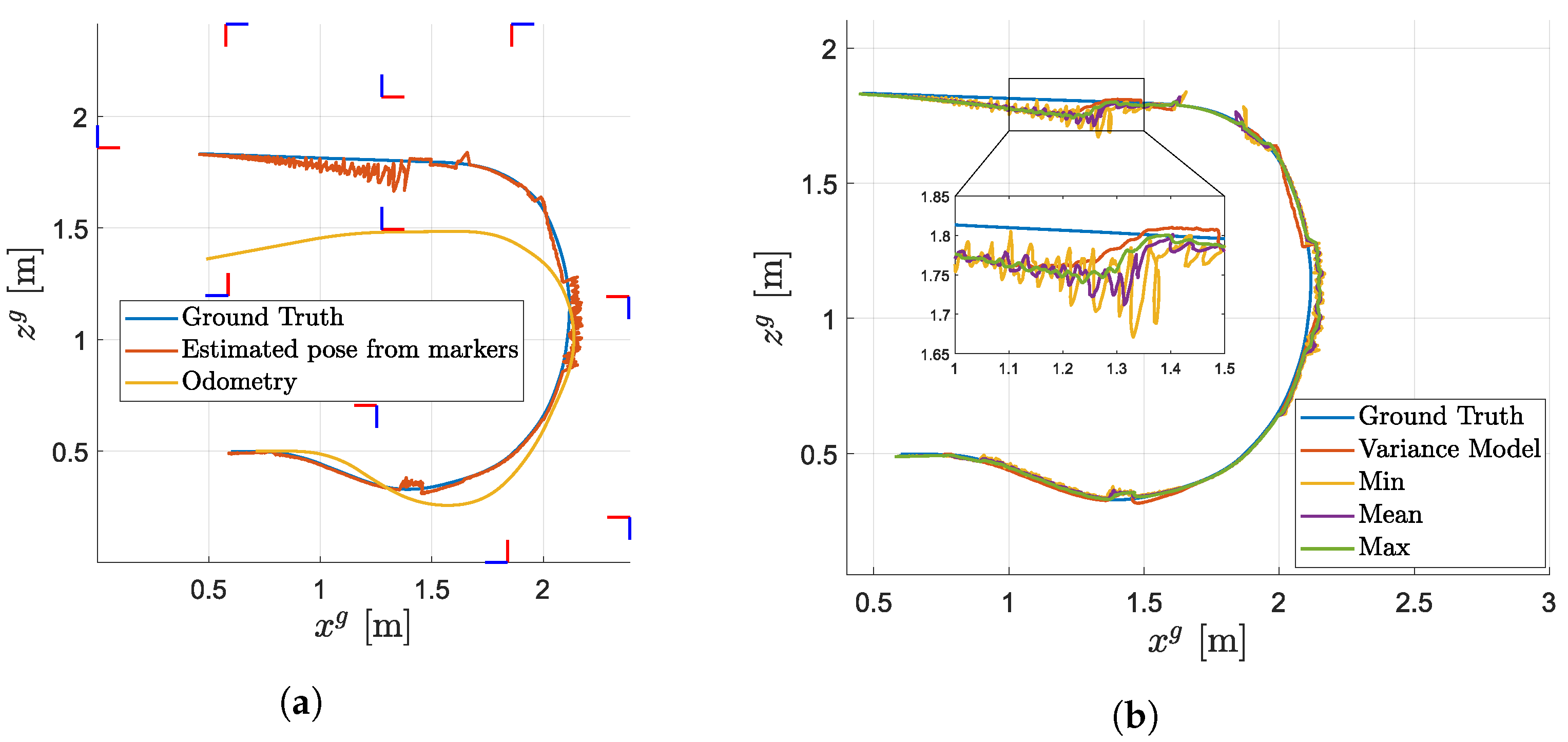
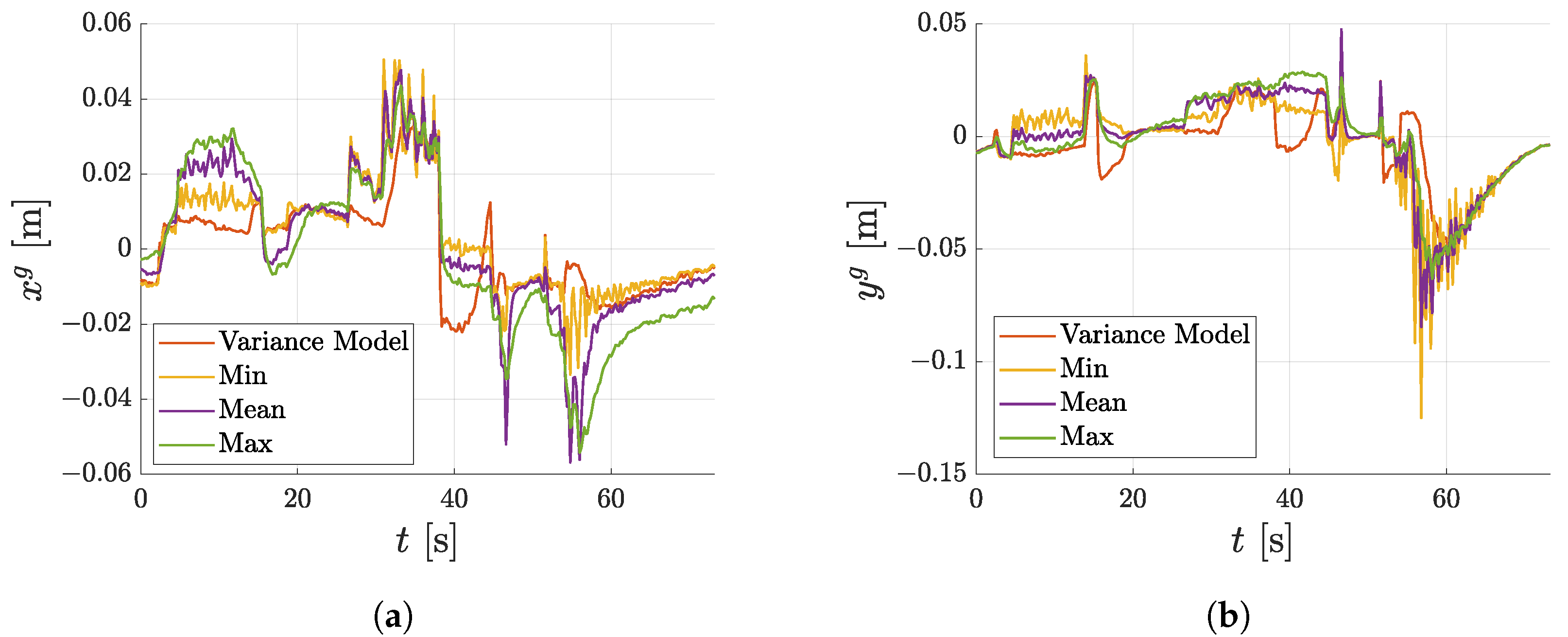
| RMSE [m] | RMSE [m] | |
|---|---|---|
| Variance Model | 0.0128 | 0.0161 |
| Min | 0.0154 | 0.0215 |
| Mean | 0.0192 | 0.0207 |
| Max | 0.0223 | 0.0203 |
Disclaimer/Publisher’s Note: The statements, opinions and data contained in all publications are solely those of the individual author(s) and contributor(s) and not of MDPI and/or the editor(s). MDPI and/or the editor(s) disclaim responsibility for any injury to people or property resulting from any ideas, methods, instructions or products referred to in the content. |
© 2023 by the authors. Licensee MDPI, Basel, Switzerland. This article is an open access article distributed under the terms and conditions of the Creative Commons Attribution (CC BY) license (https://creativecommons.org/licenses/by/4.0/).
Share and Cite
Adámek, R.; Brablc, M.; Vávra, P.; Dobossy, B.; Formánek, M.; Radil, F. Analytical Models for Pose Estimate Variance of Planar Fiducial Markers for Mobile Robot Localisation. Sensors 2023, 23, 5746. https://doi.org/10.3390/s23125746
Adámek R, Brablc M, Vávra P, Dobossy B, Formánek M, Radil F. Analytical Models for Pose Estimate Variance of Planar Fiducial Markers for Mobile Robot Localisation. Sensors. 2023; 23(12):5746. https://doi.org/10.3390/s23125746
Chicago/Turabian StyleAdámek, Roman, Martin Brablc, Patrik Vávra, Barnabás Dobossy, Martin Formánek, and Filip Radil. 2023. "Analytical Models for Pose Estimate Variance of Planar Fiducial Markers for Mobile Robot Localisation" Sensors 23, no. 12: 5746. https://doi.org/10.3390/s23125746
APA StyleAdámek, R., Brablc, M., Vávra, P., Dobossy, B., Formánek, M., & Radil, F. (2023). Analytical Models for Pose Estimate Variance of Planar Fiducial Markers for Mobile Robot Localisation. Sensors, 23(12), 5746. https://doi.org/10.3390/s23125746






